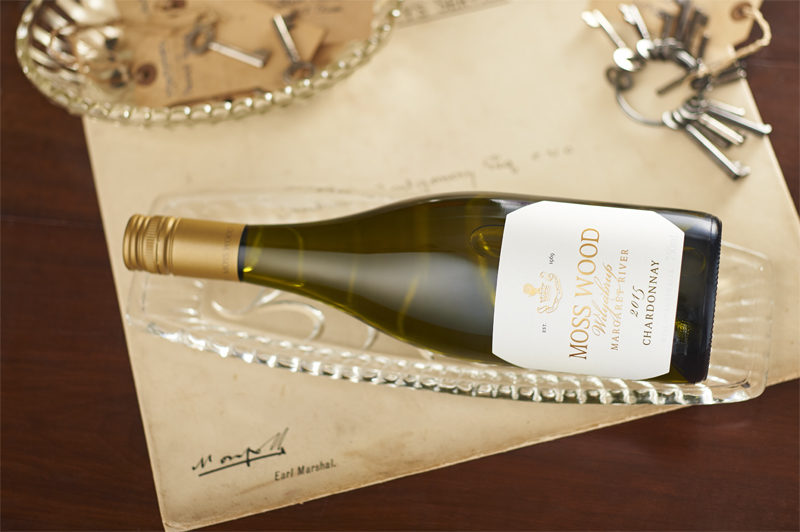Moss Wood Newsletter Spring News Issue #93, October 2016
Moss Wood 2015 Chardonnay
Moss Wood 2011 Pinot Noir
Moss Wood 2016 Semillon
Moss Wood Ribbon Vale 2016 Sauvignon Blanc Semillon
Moss Wood 2011 Pinot Noir
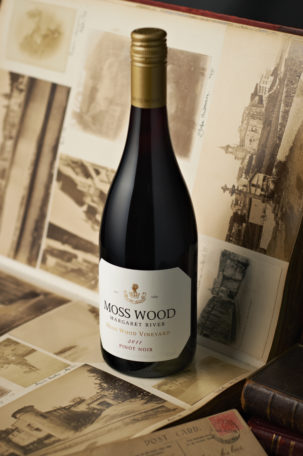
Median Harvest Date
8th February, 2011
Mean Harvest Ripeness
12.70 Baume
Yields
9.36 tonnes per hectare
Ripening Time from Flowering to Harvest
105 days
Looking back, calendar year 2010 is easily summarised as cool to mild and dry, with rainfall down 11%. However, by the end of October, when the vines flowered, the weather had begun to warm up and the Pinot Noir positively sprinted through the process, completing it in 14 days and was no doubt assisted by 8 days where the temperature got over 250 C.
From then on things remained warm, encouraging consistent ripening. In particular, December temperatures were slightly above average and February was a genuinely warm one. At 23.760 C mean temperature it was essentially 20 C higher than normal and brought the vintage on with a bit of rush.
With the excellent flowering conditions, it was no surprise that yield was good. Both our clones, D4V2 and D5V12a were above average and across the Pinot Noir vineyard as a whole, the yield of 9.36 tonnes per hectare, a very significant 49% above average, leading to a slight change in winemaking technique which
we’ll discuss later.
With the warm February temperatures things got moving and having started the season a little behind schedule, both clones caught up to an almost average harvest date. D4V2 achieved its final ripeness of 130 Baume on 15th February and D5V12a reached 12.50 Baume on the 21st February. This gave a median harvest date of 18th, 4 days earlier than the mean.
After hand picking, the fruit was taken to the winery and destemmed into small, open fermenters. With such good quantities and in light of Pinot Noir’s sensitivity to high yields, we drained off 20% of the juice to help improve the concentration of the skins, to ensure there was no lack of colour or flavour.
After 2 days of soaking at 100 C, the must was allowed to warm, was seeded with selected yeast strains for primary fermentation and which progressed at temperatures up to 320 C. After 14 days on skins each batch was pressed to stainless steel and all underwent malolactic fermentation.
After MLF, both batches were racked to oak on 23rd March 2011, all barrels were 228 litre French, and 10% were new. After almost exactly 18 months, the wine was racked to stainless steel on 17th September, 2012 and underwent fining trials. After tasting we concluded the wine needed no treatments and so it was sterile filtered and bottled on 15th October, 2012.
Moss Wood readers will note this wine is being released after the 2012, 2013 and 2014 vintages. The reason is quite simple. As a youngster, it was a firm beast, dominated by a strong tannin structure and a vintage that we felt needed to settle and age before we could release it. Having been bottled now for 4 years, this wine is starting to really hit its straps and so we feel
it’s ready to enter the market.
Its colour is still youthful, with medium to deep ruby and garnet notes and little or no development. The nose presents as classical Pinot Noir, displaying red and dark fruits of strawberry, cherry and plum but it is also now beginning to show complexity with classic leather and earthy notes, as well as some spice and tar. On the palate, there is a similar effect, with generous plum and strawberry flavours, sitting over a well-balanced structure of acidity and tannin, firm but not aggressive and giving
the wine real length.
At 5 years of age, the wine is essentially still “young” and dominated by its fruit characters. It has really only just begun to show hints of bottle development. That gives us great confidence that it’s on track to be repay long term cellaring and our current expectation is it will need at least another decade to reach
full maturity. More importantly, however, by virtue of the delayed release, it is one of the most settled and balanced Moss Wood Pinot Noirs we have offered and is very enjoyable now.
Moss Wood 2015 Chardonnay
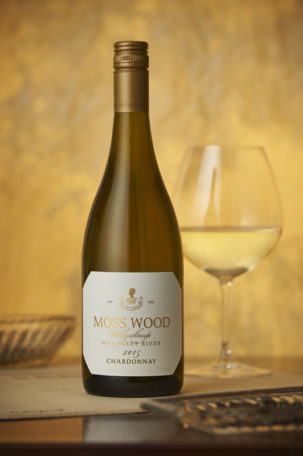
Median Harvest Date
6th February, 2016
Mean Harvest Ripeness
12.60 Baume
Yields
6.24 tonnes/hectare
Ripening Time from Flowering to Harvest
117 days
Before we go into commentary about this new release, we’d like to point out that this calendar year is something of a milestone for our Chardonnay. As we write this newsletter, it is almost exactly 40 years ago to the day since it was first planted at Moss Wood, making us one of the few vineyards in Australia that have genuinely old Chardonnay vines and we can only hope we are doing justice to the grapes these grand old things are producing.
Spring 2014 was definitely one for vineyard managers who enjoy a challenge, with regular rainfall that tested our spray program, as well as causing havoc while the vines were flowering. As an amusing aside, 2014 was the wettest year in the 37 that we have been involved at Moss Wood – 1245mm rain fell, some 26% above average. When we have lots of rain, temperatures remain mild, so in 2014 we had an extended flowering period of 48 days, nearly twice as long as normal. Fortunately, this also meant overnight temperatures were generally higher, something the vines really enjoy and probably offset the rain to a degree. In the end the final yield of 6.24 tonnes per hectare was
only 10% down.
The remainder of the growing season was positively splendid. Temperatures were mild to warm and we didn’t register a day over 370 C. The vines experienced nearly endless hours in their preferred range for photosynthesis and it could be said the Chardonnay strode slowly, steadily and gracefully to its harvest date of 16th February, when it had achieved a ripeness of 12.60
Baume.
All the fruit was hand-picked then whole bunch pressed, with the juice collected and racked to stainless steel tank, where it was settled for 48 hours.
The clear juice was racked to stainless steel and fermentation commenced, using a variety of yeasts. Once the initial, aggressive stage was completed in the controlled temperature environment of the tank, the wine was then racked in to barrel. All barrels were 228 litre French oak and 45% were new. It stayed in barrel for 19 months and during that time underwent a full malolactic fermentation.
In September the wine was racked from barrel, fined for heat stability, then sterile filtered and bottled on 11th October, 2016.
In keeping with such a good season, this wine has much to recommend it. The colour is light to medium straw, with green tints and the condition is bright. The nose has significant volume, with ethereal aromas of limes and blossom, sitting over Chardonnay’s riper fruit characters of peaches and nuts. Lightly toasty oak notes sit in the background, along with subtle cheese and meaty notes.
This complexity follows along the palate, where there are bright lime, peach and roast cashew flavours. Structure is firm, with high acidity and some tannins on the finish but this is balanced by full and excellent length.
Cellaring time will be typical Moss Wood, with the wine requiring at least 10 years aging to develop the beginnings of its bottle bouquet but a further 10 years beyond that to reach full maturity. In the meantime, it will be just as rewarding to consume as a youngster, where its bright fruit characters make it easy to enjoy
Moss Wood 2016 Semillon
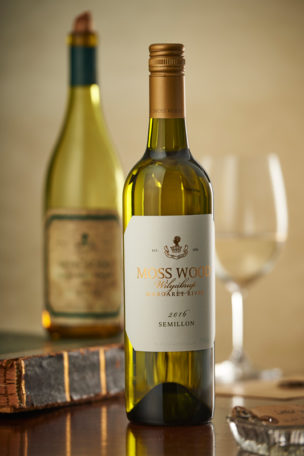
Median Harvest Date
8th February, 2016
Mean Harvest Ripeness
130 Baume
Yields
3.36 tonnes/hectare
Ripening Time from Flowering to Harvest
101 days
Looking back at the 2015/16 growing season, from a viticultural perspective, it was very agreeable. Annual rainfall for 2015 was good, albeit very slightly below average, at 959mm and Springtime conditions were benign, with no wind or hail damage. Yet, as is her way, Mother Nature saw fit to throw in a couple of challenges, just to keep us on our toes. Through the flowering period, temperatures were mild and Semillon took 4 weeks to complete the process, roughly a week longer than usual.
Through that period the vines experienced 9 days where the temperature dropped below 80 C and also received 52mm rain and neither of these are good for the process. At the time, we were suspicious yields may be affected and regretfully were proven correct. The crop was down by a whopping 67% to 3.36
tonnes/hectare. Further investigation revealed both bunch weights and bunch numbers were down by around 30%.
Despite an early signal of low yields, in classic Moss Wood fashion, we remained optimistic leading up picking. During January we received 112mm rain and in February a further 20mm. This can be a blessing and a curse, depending on just when it falls and this year it was a blessing. The earlier rain came when the fruit was still green, so it didn’t split, and we avoided bunch rot. When the later falls occurred, the vines had adapted, they had got used to the water uptake, so once again, there were no problems with splitting or the oft resulting disease. For unirrigated vineyards like Moss Wood and Ribbon Vale, summer rain is always welcome and this meant we were confident it would solve any yield deficiency associated with poor flowering. How wrong we were!
More importantly, as far as temperature goes, the season was near-perfect. Mild conditions prevailed throughout, with no temperatures over 400 C and indeed only 2 days when the mercury got above 380 C. Yet there was an abundance of the right temperatures for ripening, with the Semillon receiving 894 hours between 180 C and 280 C and 56 hours above 330 C, more than enough to accumulate sugar and achieve good flavor maturity. By harvest time it had reached a ripeness of 130
Baume, having taken 101 days to get there.
The grapes were hand-picked, as for all our wines, then destemmed and pressed and the juice was cold settled for 48 hours. After settling the clear juice was racked into stainless steel where fermentation was carried out using various yeasts in sequential inoculations. After fermentation the wine was fined for heat stability, sterile filtered and bottled on 28th June, 2016.
Amongst those of us at the winery, the 2016 vintage is one of our very favourites and this is especially true with the Semillon. It is a tribute to the variety that a wine can be so complete with such simple technique. The colour is light to medium straw, with green
tints and the condition is bright. The nose is lifted and scented with fruit aromas of green pea, lemon sherbet, figs and apples, so fresh, in fact, the classic lanolin and oily notes are, for the moment, sitting very much in the background. On the palate, the effect is the same and absolutely classic Semillon in style, with lemon, apple and fig flavours sitting atop lively acidity and firm tannin, all combining to give great texture and length.
Any discussion of cellaring seems almost superfluous. There is such drinkability in the young wine it is delicious now and yet its intensity and structure will see it age for decades, literally. Perhaps it’s best to make our usual Moss Wood Semillon observation. For those who enjoy the mature characters, it is best kept for a minimum of 10 years, by which time it will have developed a little of the bottle bouquet but for those who want to see it at full maturity, 20 to 25 years is the recommended cellaring.
Moss Wood 2016 Semillon
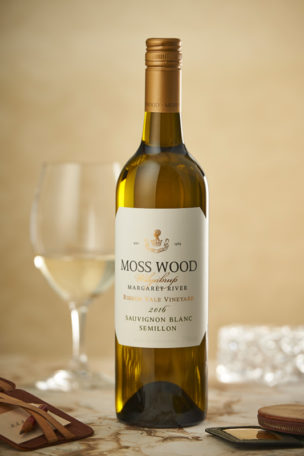
Median Harvest Dates
Sauvignon Blanc – 10th February, 2016
Semillon – 11th March, 2016
Mean Harvest Ripeness
Sauvignon Blanc Semillon – 11.50 Baume
Yields
Sauvignon Blanc Semillon – 6.47 tonnes/hectare
Ripening Time from Flowering to Harvest
Sauvignon Blanc – 87 days
Semillon – 123 days
Many among you reading this may be getting a tingle of déjà vu, as you read the above heading. Yes, we have told you about and offered you this wine before. Our 2015 Ribbon Vale Sauvignon Blanc Semillon sold out abruptly in July this year and we sent a quick, email only newsletter, to let you know that we could make the 2016 available to you. Now we are doing the wine the courtesy of including it in a newsletter with its Moss Wood siblings, as we would usually do.
We have written enthusiastically about the 2016 vintage and the quality it produced in the Moss Wood Semillon and we are just as
excited about the results for the Ribbon Vale Sauvignon Blanc and Semillon. Both varieties had a near copybook growing season, yields notwithstanding.
The Sauvignon Blanc sailed through the ripening process and reached its required ripeness of 11.50 Baume on 10th February. This was 2 weeks ahead of average, but this is not really a surprise, given its yield was down by 39%, to 6.47 tonnes per hectare. Similarly, the Semillon yield of 4.91 tonnes per hectare, was down 51%.
There was an interesting difference between the seasons for the two varieties. Despite such a small crop, the Semillon ripened noticeably slower than the Sauvignon Blanc. It took 123 days from flowering to reach its average Baume of 13.10, on 11th March, some 11 days longer than average. Sauvignon was basically spot on its average at 87 days. Both had low yields so why the difference? The answer seems to be in the timing. Our late summer and early autumn temperatures dropped quite noticeably which meant the Semillon completed its ripening in significantly cooler conditions. Perhaps we should be thankful the crop was small because this has given the wine some delightfully lifted aromatics.
As with the Moss Wood Semillon, both varieties coped with the summer rain, with little or no issue with disease. Sauvignon Blanc had a tiny amount of Noble Rot, which we think has added an extra dimension on the nose. It’s an interesting point because at the end of fermentation, the wine was dominated by strong varietal aromas but after aging in barrel, while retaining these, it began to show other complex notes that added to the background. It seems the botrytis was more influential in the wine than we first thought.
The production techniques for both varieties are both very similar. Harvesting was done by hand and the fruit was destemmed and pressed, the juice settled for 48 hours and finally the clear juice was racked to stainless steel and seeded for fermentation. A varying selection of yeasts were used to promote aromatic lift and ferment proceeded in tank until the halfway point and the juice was then racked to barrel. All the barrels were 228 litre French oak but none were new. We are not looking to impart oak character to this wine. Rather, we are keen to get the textural improvement that comes from fermenting in small oak.
At the completion of primary ferment, the individual batches of Sauvignon Blanc and Semillon were racked from barrel and blended and the completed wine was then given a further 3 months aging.
At the beginning of June all barrels were racked to stainless steel in preparation for bottling. The wine was fined for protein stability, cold stabilised and then sterile filtered and bottled on
27th June, 2016.
All of this activity has combined to give a wine that, first and foremost, speaks of the varieties from which it is made. The nose displays lashings of leafy, grassy Sauvignon Blanc, mixed with more generous notes of fig and honey from the Semillon.
Underneath all this primary grape aroma is a distinct apricot note, which we note above and put down to just a touch of Noble Rot in the fruit, as well as some complexity from Semillon’s lanolin character. This character should not in any way be confused with the influence of botrytis in the natural sweet wines we have made from our Ribbon Vale. The palate is medium bodied and the fresh fruit emphasis is highlighted by crisp acidity and a soft finish. It is a delightfully fresh wine and easily enjoyed as a youngster but this belies its structure and fruit depth, that will see it age gracefully for 5 to 10 years.
Order
OUR WINES:
Contact
MOSS WOOD:
Location: 926 Metricup Road, Wilyabrup WA
Postal: PO Box 225, Cowaramup WA 6284
Phone: +61 8 9755 6266
Fax: +61 8 9755 6303
Follow us on
SOCIAL MEDIA:

